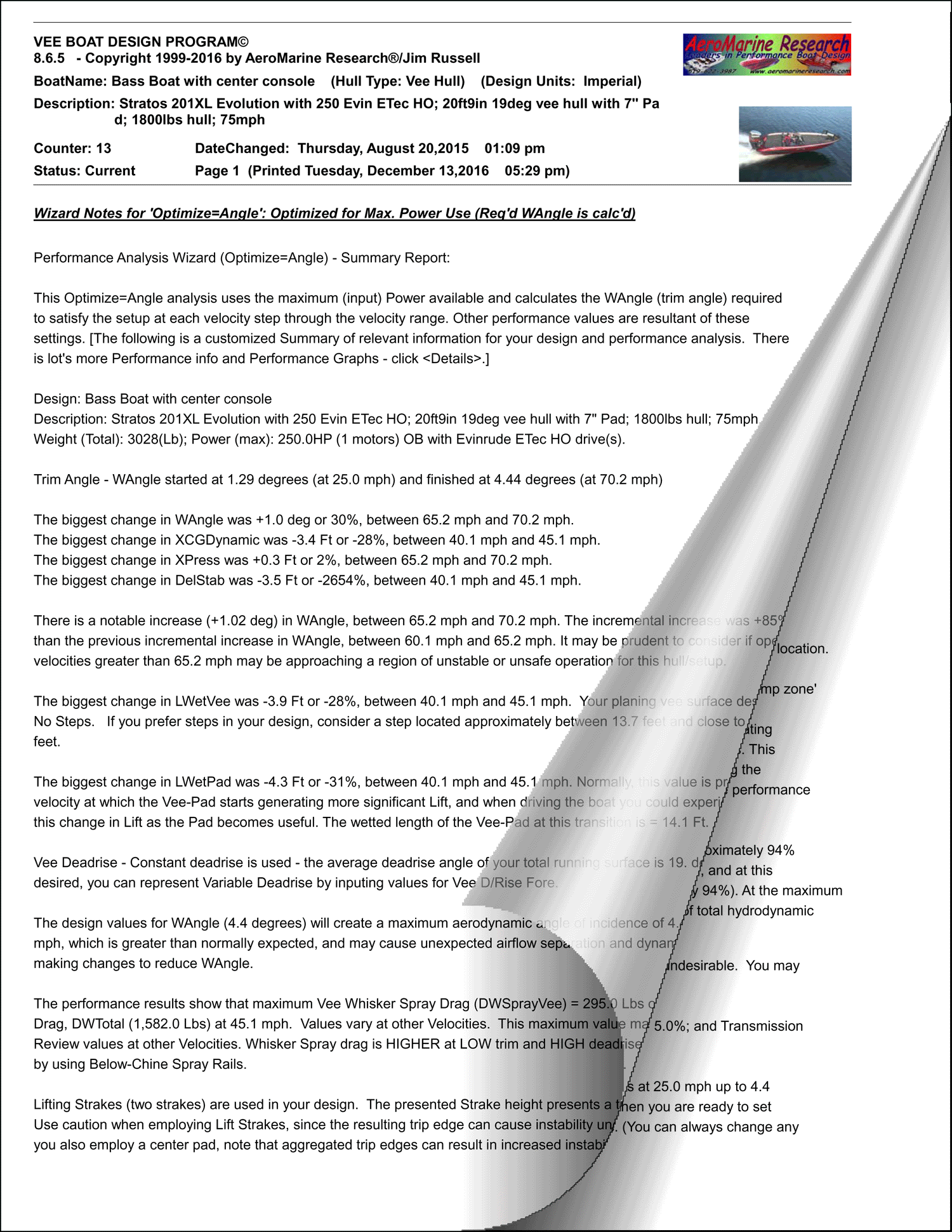|
NAME |
UNITS |
DESCRIPTION |
|
Velocity |
(mph) |
CONFIGURED for ANGLE
OPTIMIZATION or POWER OPTIMIZATION - velocity is set at Design data input
screen by STARTVEL and VELOCITY INCREMENT to determine the range of
velocities that predictive performance analysis will be completed for.
Solutions for (6) specified velocities will print in columns on the
performance analysis screen.
CONFIGURED FOR VELOCITY OPTIMIZATION -
velocity is predicted through Optimization program. The velocity that
satisfies the specified Angle of Attack and Power Rating is determined.
NOTE: This may be the maximum attainable velocity. There may also be other
velocities for which the design produces solutions for the specified
input values. The "singular solution" for maximum velocity can be
determined by specifying an alternate STARTVEL or varying POWER MAX to
examine these alternate modes. |
|
LWetSponson |
(ft) |
Sponson wetted length, limited to maximum length of
sponson (LENGTH BOAT). |
|
LWetVee |
(ft) |
Vee surface wetted length, limited to maximum length
of vee bottoms (LENGTH BOAT). |
|
SWet |
(ft2) |
Total wetted sponson area, limited to total plan area
of both sponsons. Less is better, can be minimized by increased
WANGLE or increased PADWIDTH |
|
SWetVee |
(ft2) |
Total wetted vee surfaces area, limited to total plan
area of vee surfaces. Less is better, can be minimized by
increased WANGLE or increased 1/2 Vee Width |
| LAero |
(lbs.) |
Total Aerodynamic Lift |
|
DAero |
(lbs.) |
Total Aerodynamic Drag |
| LWTotal |
(lbs.) |
Total Hydrodynamic Lift |
| DWTotal |
(lbs.) |
Total Hydrodynamic Drag |
| DMotor |
(lbs.) |
Total drag of motor appendages , includes motor spray drag
(if applicable) and multi-engine interference drag (if applicable). |
| DCockpit |
(lbs.) |
Total drag of cockpit/cowl, including cavity drag (if
applicable) |
| DTotal |
(lbs.) |
Total Combined Drag, sum of all other drags, required to be
balanced by available power (POWER MAX). |
| WtTotal |
(lbs.) |
Total Combined Weight of Boat, Driver, Motor, Fuel and all
miscellaneous hardware. |
| XCGStat |
(ft) |
Location of Static Centre of Gravity (dead balance of
boat), referenced fore (+) of the |
| XCFDynam |
(ft) |
Location of Dynamic C of G, center of balanced moment
of all forces while hull is under specified running conditions, referenced fore (+) of the
transom location. This will bedifferent for each operating velocity or condition.
[HINT : To maximize stability at operating velocity,
XCFDynam should be as close toXCGStat as possible, and XCFDynam should be ahead of the
Aerodynamic Center (XPress).Location of weight (e.g. LENGTH DRIVER, LENGTH FUEL) and
location of forces (WINGCHORD, LENGTH BOAT) can be adjusted to
optimize desired performance.
[NOTE: See also, XCFDynamic Analysis , and Example Analysis
of XCFDynamic & XCGStatic] |
| WAngle |
(degrees) |
CONFIGURED for VELOCITY OPTIMIZATION or
POWER OPTIMIZATION - the specified Angle of Attack (Trim Angle)
used for predictive performance analysis. Referenced as angle
between water surface and sponson bottoms.
CONFIGURED FOR ANGLE OPTIMIZATION - the calculated Angle of
Attack (Trim Angle)predicted through Optimization program, based
on defined VELOCITY inputs. |
| XPorpoise |
(Ratio:1) |
a) If XPorpoise is GREATER THAN 1.0 - When your hull
is in the "stable planing range", the hull is less
likely to experience porpoising. This is a good feature, and
your hull will be lesssusceptible to porpoising while operating
in this range.
b) If XPorpoise
is LESS THAN 1.0 - When your hull is in the "Porpoise
instability regime", itis susceptible to porpoising. If
porpoising is a performance concern, this is a risk region
ofoperation. |
| PReqd |
(HP) |
Calculated POWER REQUIRED, as predicted through
iterative Optimization program , to meet specified VELOCITY or
ANGLE requirements.
For
VELOCITY and ANGLE Optimization , solutions are reached and are
displayed when thecalculated Power Required meets the specified
maximum power (POWER MAX) within thetolerance range specified by
ACCURACY DEF and at the specified VELOCITY or ANGLEvalues.
For POWER Optimization, solutions are reached and are
displayed when the minimumpower required to meet the specified
trim angle (WANGLE) at the specified VELOCITY. |
| Time |
(sec) |
Estimated ELAPSED TIME to accelerate using FULL POWER
from one VELOCITY to the next.This is an approximated calculation, but very useful in
performance prediction and designcomparisons. |
| Accell'n |
(fps/ sec) |
Estimated average ACCELERATION rate using FULL POWER
from one VELOCITY to thenext. This is a tremendously powerful analysis tool, to
evaluate the NET impact that designchanges or differences can/will have on real-life
performance characteristics. This is anapproximated calculation, but very useful in performance
prediction and designcomparisons. |
| Distance |
(ft) |
Estimated (cumulative) DISTANCE TRAVELED during
acceleration from one VELOCITY tothe next, based on user
specified trim angles (WAngle). This is an approximated
calculation, but very useful in performance prediction and
design comparisons. |



